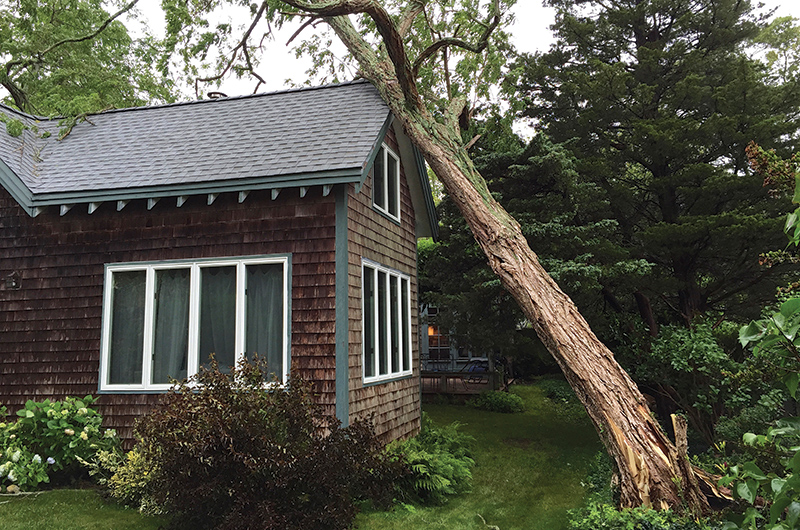It used to be the demands were relatively low and a guy (or gal) with a tall stepladder and some rudimentary carpentry skills could care for the relatively simple summer homes that were shuttered after Labor Day. They were and are called caretakers, and except for a panicked call about skunks or re-plumbing a cranky screen door, they mostly enjoyed their summers while the owners were in residence.
For Steve Flanders of Chilmark, for instance, caretaking was a natural extension of his carpentry work. Initially, it meant picking up a few properties to supplement his income, but eventually it became his sole occupation. Now caring for four favored homes and homeowners, he once managed fourteen properties.
The caveat? You couldn’t hire Flanders if your house was outside his self-imposed ten-mile radius. “My great fear was always if a hurricane was coming, because there’s no way I could suddenly button up fourteen houses,” he said.
“I always got a kick out of the ones who were constantly looking at the weather and would call me about this northeaster or that storm,” he recalled. “And I’d always tell them the wind blows like hell here all the time and if you don’t hear from me, everything is fine. But if I call you in February, we’ve got a problem.”
But the local caretaker served up with a dash of Island character is a breed that, while not entirely dying off, has been morphing into the business of full-service property management. There are even national franchises, such as Turnkey and Vacasa, that manage thousands of properties around the world and are looking to manage Vineyard properties as well.
Going with a simple caretaker who primarily checks the property in the off-season and is on call in-season typically runs in the neighborhood of $150 a quarter. By contrast, a full-service property management team can run between $1,500 to $7,500 a year, depending on several factors, from the size of the property, to rental responsibilities, to whether or not there’s an expectation of concierge-like services. As for repairs? Always extra: expect fees between $50 to $100 an hour plus materials.
The choice of caretaking level usually relates to the size of the property and whether or not the seasonal owner rents out the home, said Anne Mayhew, owner/broker of Sandpiper Rentals, Inc. “Some homeowners prefer to do the maintenance and organization themselves and just want someone to call if there’s a problem,” she said. “And a lot of caretakers don’t want to work with someone who rents.”
Luis D’Agostino, a New Jersey boy who married an Island gal, understands why some of his fellow caretakers might avoid dealing with other people’s renters. He owns Quitsa Landscape and Home Care and, depending on the time of year, employs two to ten workers to service sixty clients and their properties from Aquinnah to Chappaquiddick. “I’ve had everything from [renters] asking me for an ironing board on the Fourth of July to one rental tenant asking me to come pick up their dog’s poop in the yard,” he said. The answer both times was “can do,” even if the tenant in question didn’t catch the giant eye roll.
D’Agostino seems to have the right personality to handle the rush of summer emergencies. “One of my issues is I don’t want to disappoint people, but it’s a great strength in this business,” he added. “Honestly, most of the time it’s simply picking up the phone and talking to people – that’s 90 percent of the job. The other piece? Showing up when I said I would.”
The cushiest jobs on the caretaking spectrum are at the compounds of the absurdly wealthy, where one or more people are employed full-time, sometimes with housing and healthcare thrown in, to make sure the bathroom scales have new batteries, the fire pit refrigerator has fresh marshmallows, and to otherwise make the living appear casual and carefree for the few weeks that the client is on-Island.
It’s not, however, a stress-free gig. One property manager asked to be unnamed because of an incident involving a high-visibility (read: celebrity) client and some yellow wood glue. The call came in: please fix a cabinet door that was fighting to stay closed. No problem. Some wood glue, some screws tightened, good to go. It all looked very mission accomplished until she and her co-worker couldn’t find the glue bottle. It seems after meticulously applying the glue, someone sat on the container, causing it to ooze onto the custom-made cushion covers. The caretaker used another expletive, but let’s just call it an energized “whoops.”
This is where the concept of a full-service team is handy. The interior designer who answered the panicked call instructed them to remove the covers and bring them immediately. Whatever she did worked well enough that unless you knew the story, you’d never spot the mishap. And no one is talking.





